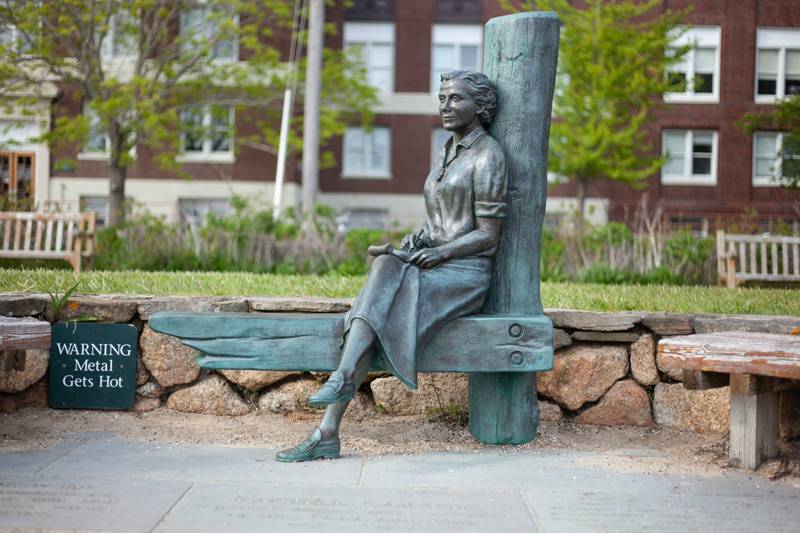2022 marks sixty years since the publication of Carson’s best-known book, Silent Spring, which helped spur the environmental movement in the United States. A statue in Waterfront Park honors the esteemed nature writer's little-known connection to the Cape Cod coast.
It’s fitting that there are ospreys wheeling over the Rachel Carson statue in Woods Hole when I visit one hot May afternoon. Sightings of these fish-eating raptors are commonplace around Vineyard Sound today, although populations were decimated in the 1950s and ’60s. The decimation can be attributed to DDT — a pesticide that rendered osprey eggs thin and crushable, until it was federally banned in 1972. And the ban on DDT? That can be attributed, in large part, to Rachel Carson.
Carson’s hit book Silent Spring helped launch the environmental movement in the U.S., and it made Carson, a former writer for the U.S. Fish and Wildlife Service, a household name. Published in 1962, Silent Spring warned against the deleterious impacts of DDT on humans and the environment. Although Carson received criticism from the chemical industry and its allies, she bravely defended her research until she died from complications of cancer in 1964.
But before Carson’s public recognition and controversy, before the science advisory committees or Silent Spring’s serialization in the New Yorker; before the Atlantic articles or the uncannily profound Fish and Wildlife brochures … there was Woods Hole.
“I had my first prolonged contact with the sea in Woods Hole,” Carson wrote, a quote now engraved beside her statue. “I never tired of watching the tidal currents pouring through the hole — whirlpools and eddies and swiftly racing water.”
The 22-year-old Carson first arrived at the Marine Biological Laboratory (MBL) in Woods Hole in the summer of 1929, just a couple of months before she was slated to begin graduate work at Johns Hopkins University. Her requests to the MBL were meager: just the “usual laboratory facilities for dissection.” But what Carson found was an artistic and scientific muse, tucked between Buzzards Bay and Vineyard Sound.
“Woods Hole is really a delightful place to biologize,” Carson wrote in a letter to a friend. “I can see it would be very easy to acquire the habit of coming back every summer.” Carson did not return to Woods Hole every summer, but she did return often. She learned to swim here. She became the first woman to go to sea on a Bureau of Fisheries (now the National Marine Fisheries Service) research vessel. And the inspiration she siphoned from the sea was the impetus for some of her most impactful works. Chief among those was The Sea Around Us, a 1952 National Book Award winner, and the second book in Carson’s “sea” trilogy. The Sea Around Us catalogs a near-complete natural history of the ocean, poetically spanning the whole of geologic time in the course of just 200 pages.
“There is no doubt that the genesis of … The Sea Around Us … belongs to this first summer in Woods Hole,” Carson’s biographer, Linda Lear, wrote. And so it was in Woods Hole that Carson’s publishers staged the publicity photo for The Sea Around Us — the very photo on which her statue is based.
In it, the author is posed with a pen and a notebook at Sam Cahoon’s Fish Market, not far from the Steamship Authority dock. Her eyes are turned seaward, and although there is a calm pensiveness about her gaze, it is likewise resolute, determined. Perhaps not the idealistic gaze of a young woman looking toward a future in marine biology, but of a woman who knew enough of the Earth’s history to have some reservations about the Earth’s future. A future when, on an unseasonably warm May day, the sun will render the bronze sculpture scalding hot — hot enough that the caretakers of Waterfront Park will erect a warning sign.
So when sculptor David Lewis cast Carson’s face, he changed the original image slightly, adding just a hint of a smile. Because after all, Carson was in Woods Hole, looking towards the sea she so loved. Because yes, it may be getting hot. The surf may creep closer to the statue’s skirts each year. But as long as there are Rachel Carsons, those who champion science and the environment against all odds … there may also be ospreys.


Beautiful tribute to one of my heroes!! Thank you.